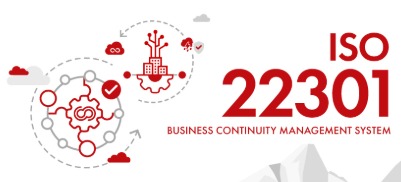In today’s interconnected and unpredictable world, organizations face a wide range of potential disruptions — from natural disasters and pandemics to cyberattacks, system failures, and political instability. These unforeseen events can severely impact business operations, causing financial losses, damaged reputations, and loss of customer trust. To mitigate these risks, organizations must adopt a proactive approach that ensures they can continue critical functions during and after a crisis. This is where ISO 22301:2019 – Business Continuity Management System (BCMS) comes into play.
What is ISO 22301?
ISO 22301 is an internationally recognized standard developed by the International Organization for Standardization (ISO) that specifies the requirements for establishing, implementing, maintaining, and improving a Business Continuity Management System (BCMS). The standard provides a structured framework that helps organizations prepare for, respond to, and recover from disruptive incidents, ensuring continuity of operations.
The latest version, ISO 22301:2019, replaces the earlier 2012 edition and emphasizes performance-based outcomes, leadership involvement, and a strategic approach to business continuity. It aligns with other ISO management system standards, such as ISO 9001 (Quality Management) and ISO 27001 (Information Security), making integration seamless for organizations already following these frameworks.
Purpose of ISO 22301
The main purpose of ISO 22301 is to ensure that businesses are well-prepared for disruptions and can continue delivering essential products and services under adverse conditions. It provides tools and methodologies for identifying potential threats, assessing risks, and implementing recovery strategies that align with the organization’s goals and stakeholder expectations.
A well-implemented BCMS based on ISO 22301 helps organizations:
-
Identify critical business processes and dependencies
-
Assess potential risks and their impacts
-
Develop strategies for maintaining or restoring operations
-
Enhance resilience and organizational preparedness
Key Elements of ISO 22301
The ISO 22301 framework is based on the Plan-Do-Check-Act (PDCA) cycle, which ensures continuous improvement. Its main components include:
-
Context of the Organization:
Understanding the internal and external factors that affect the organization’s ability to achieve business continuity objectives.
-
Leadership and Commitment:
Top management plays a vital role in driving business continuity initiatives, ensuring alignment with organizational strategy, and allocating adequate resources.
-
Planning:
Establishing clear objectives, identifying risks, and defining strategies to ensure continuity and recovery.
-
Support:
Involves providing adequate resources, training, communication, and documentation to support the BCMS.
-
Operation:
Implementing and controlling processes required to meet continuity objectives, including business impact analysis (BIA), risk assessment, and response strategies.
-
Performance Evaluation:
Monitoring, measuring, analyzing, and evaluating the performance of the BCMS through audits and reviews.
-
Improvement:
Continuously updating and refining the BCMS based on lessons learned and changing business conditions.
Benefits of Implementing ISO 22301
Implementing ISO 22301 offers numerous advantages for organizations across industries:
1. Enhanced Organizational Resilience
The standard enables organizations to anticipate potential disruptions and establish strategies to reduce their impact. This helps in maintaining core operations even during challenging times.
2. Reduced Downtime and Financial Losses
By identifying critical business areas and dependencies, organizations can prioritize recovery actions, minimize downtime, and reduce financial damage.
3. Increased Customer Trust and Confidence
Customers and partners gain confidence knowing that the organization is prepared to deliver products and services even during emergencies.
4. Compliance and Legal Advantages
ISO 22301 helps organizations comply with legal, regulatory, and contractual requirements related to business continuity, reducing the risk of penalties.
5. Improved Risk Management
The BCMS framework integrates with existing risk management processes, offering a comprehensive approach to organizational risk handling.
6. Competitive Advantage
Organizations certified to ISO 22301 can differentiate themselves from competitors by demonstrating reliability and preparedness, particularly when bidding for contracts or partnerships.
7. Continual Improvement
The standard promotes a culture of continuous learning and enhancement, ensuring that the organization’s continuity strategies evolve with time and technology.
Industries That Benefit from ISO 22301
ISO 22301 is applicable to all sectors, but it is especially beneficial for:
-
IT and Telecommunications – to ensure data and service availability.
-
Financial Institutions – to maintain critical financial operations during disruptions.
-
Manufacturing and Supply Chain – to minimize production and delivery delays.
-
Healthcare – to ensure patient care continuity.
-
Public Sector and Government Bodies – to maintain essential services for citizens.
-
Education and Research Institutions – to safeguard information and academic continuity.
ISO 22301 Certification Process
Obtaining ISO 22301 certification demonstrates an organization’s compliance with international business continuity standards. The certification process typically involves the following steps:
-
Gap Analysis:
Assess the current system against ISO 22301 requirements to identify areas for improvement.
-
Documentation and Implementation:
Develop a BCMS framework, including business continuity policies, objectives, risk assessments, and recovery plans.
-
Training and Awareness:
Train employees and management teams on their roles and responsibilities during disruptions.
-
Internal Audit:
Conduct internal audits to evaluate the effectiveness of the implemented BCMS.
-
Management Review:
Top management reviews audit findings and ensures that the BCMS is aligned with organizational goals.
-
Certification Audit:
A third-party certification body conducts an external audit to verify compliance with ISO 22301 requirements.
-
Certification and Surveillance:
Upon successful completion, the organization receives ISO 22301 certification, followed by periodic surveillance audits to ensure ongoing compliance.
Challenges in Implementing ISO 22301
While ISO 22301 offers immense value, organizations may face certain challenges during implementation, such as:
-
Lack of top management commitment
-
Inadequate resources or expertise
-
Resistance to change from employees
-
Incomplete understanding of business processes and dependencies
-
Failure to regularly test and update plans
These challenges can be overcome by engaging skilled consultants, ensuring leadership support, and fostering a culture of preparedness.
Why ISO 22301 Matters in Today’s World
Recent global events such as the COVID-19 pandemic, data breaches, and natural calamities have highlighted the importance of business continuity planning. Organizations that had robust continuity systems in place were able to adapt swiftly, maintain services, and recover faster than those without structured plans. ISO 22301 serves as a guiding framework for such preparedness — making resilience a part of organizational culture rather than a reactive measure.
Conclusion
ISO 22301:2019 is not just about certification; it’s about safeguarding your organization’s future. It ensures that businesses can continue their essential functions regardless of the challenges they face. By adopting this standard, organizations demonstrate commitment to resilience, reliability, and customer trust.
In an era where uncertainty is the only constant, ISO 22301 equips businesses with the strength to withstand disruptions and the agility to recover swiftly. Implementing ISO 22301 is an investment in stability, sustainability, and long-term success — ensuring that no matter what happens, your organization remains prepared, protected, and operational.







